|
|
|

Richard Morris Hunt - Biltmore, Asheville, NC (1890-95)
250 rooms, largest in america, built for vanderbilts, in arboretum,
planned by olmstead
stairs based on the Blois in France

Richard Morris Hunt - The Breakers, Newport, RI (1895)
on the water, view to sea, close to street at front - porte coche (covered
door), loggia - internal porch - from italian villas,
lots of "poche" - pockets - little waiting rooms, closets, etc.
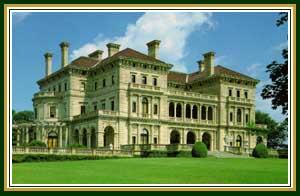
Richard Morris Hunt - Griswold House, Newport, RI (1862)
quintessential stick style, braces for house, wrapped in own scaffolding,
(scully #15) reminiscent of Europe, can tell its early because its so
reminiscent of Tudors and alpine cottages, open spaces, living hall
is heart of home "queen anne english," informal symmetry, knee braces of
frame,
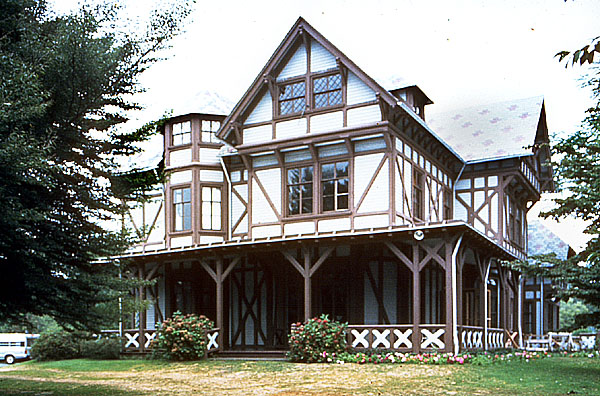
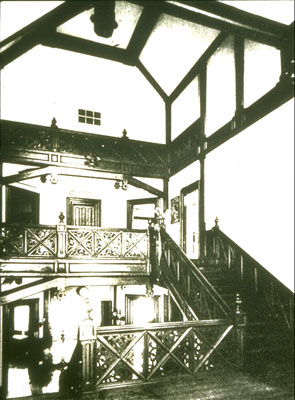
John Russel Pope - Scottish Rite Temple, Washington, DC (1911)
neoclassical, used lots of stone, limestone outside, marble inside,
based on the tomb of Halikarnassos

John Russel Pope - Train Station, Richmond, VA (1913)
very roman,
John Russel Pope - National Archives, Washington, DC (1935)
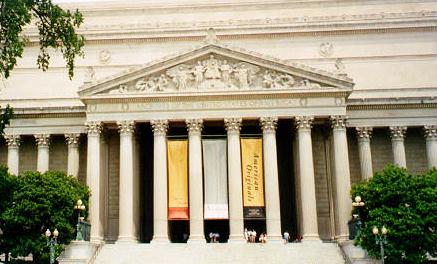
John Russel Pope - National Gallery of Art, Washington, DC (1941)
part of MacMillan plan, on the mall, pink tennessee marble, huge side
door, blind windows, skylight,
contains stuff originally housed in Mellon's house, lots of surface
walls, no windows, austere, steel structure
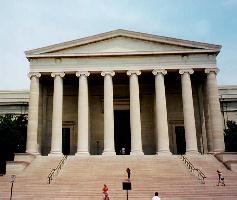
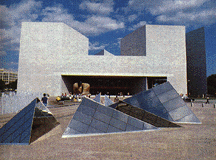
John Russel Pope - Jefferson Memorial, Washington, DC (1938-41)
like Pantheon, pavillion - open gazebo-like structure
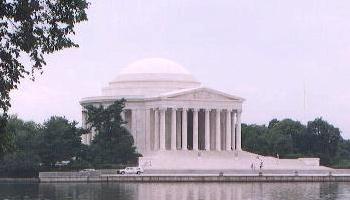
Carrere and Hastings - New York Public Library, NY (1902-09)
on 42 st.
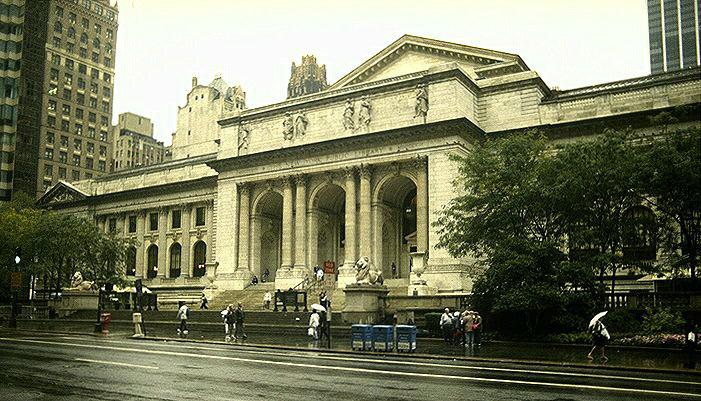
Carrere and Hastings - Frick House / Art Gallery, NY (1914)
71st and 5th
McKim, Mead, and White - Villard Houses
ren. palace, U-shaped plan with central court, quoining makes it look
more stable
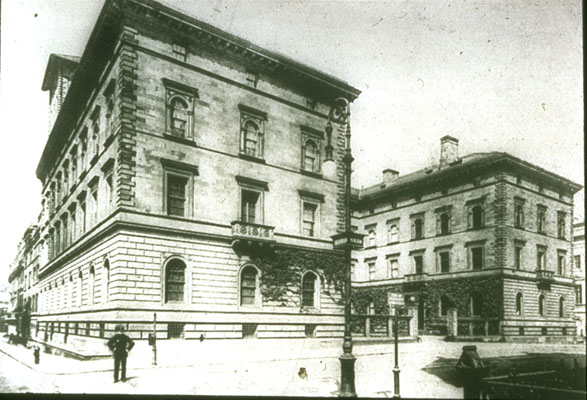
McKim, Mead, and White - Boston Public Library, MA (1887-95)
based on Paris library by Bruste (1834), function follows form with
thermal windows (roth 194)

McKim, Mead, and White - Vanderbilt House, Hyde Park, NY (1895-98)
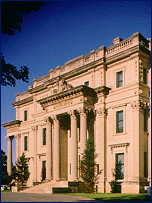
McKim, Mead, and White - Pennsylvannia Rail Road Station, NY (1902-11)
based on Roman baths at Caracalla, (roth 195)
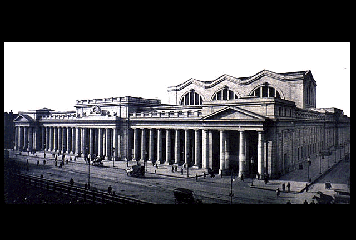
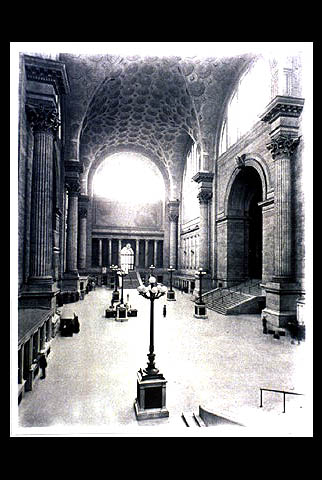
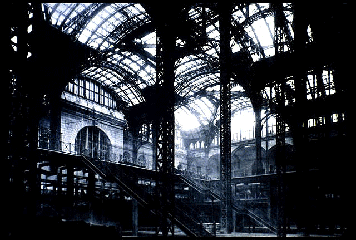
McKim, Mead, and White - Madison Square Gardens and Presbyterian
Church, NY (1903-06)
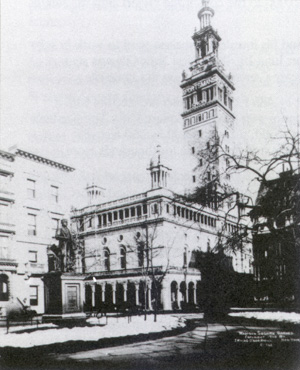
McKim, Mead, and White - The Morgan Library, NY (1906)
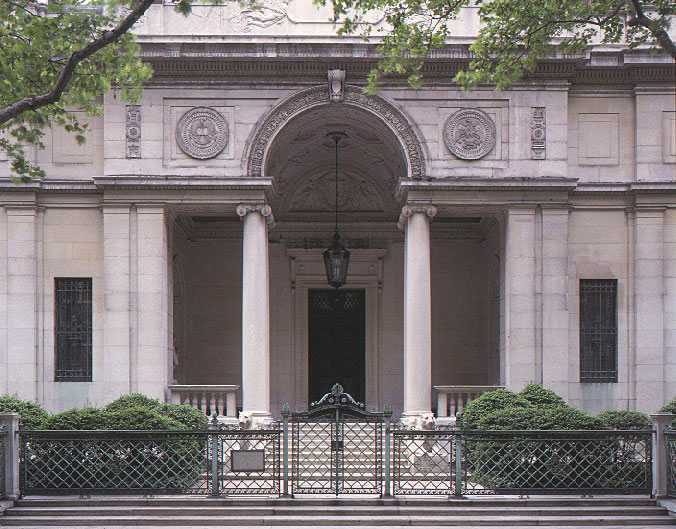
McKim, Mead, and White - Southside, Newport, RI (1882)
emphasis on hall, huge two story fireplace, temple-like on either side,classical
influences, plaster panels give textural warmth on top of door,
asymmetric, large piazza, towers,
McKim, Mead, and White - Isaac Bell House, Newport, RI (1882)
(scully #1129, 131) upper porch stick style, house covered in shingles,
piazza covered (sun phobic), large central hall, top level plays on scale,
have to walk around to get in, big windows when you expect small, temple-like
classicism on left, tower swelling from one side is balanced by two story
semicircular veranda on other, influenced by colonial and japanese architechture
as well as classical, eclectic (roth 158)
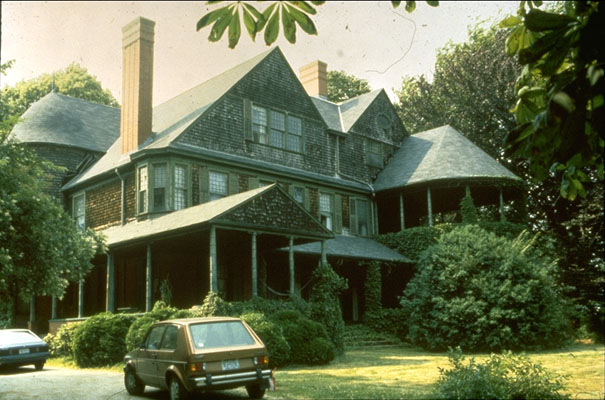
McKim, Mead, and White - Metcalfe House, Newport, RI (1882)
good inglenook and basketry woodwork, (scully #137, 138) ugly exterior
McKim, Mead, and White - Naumkeag, Stockbridge, MA (1886)
turreted - victorian,
McKim, Mead, and White - Low House, Bristol, RI (1886)
burned in 1950s, just one gable, scale - huge house, but looks small,
porch included on right, anti-picturesque, bay windows grouped together
with horizontal overhangs, bilateral symmetry, "the apogee of formal clarity"
(roth 158)
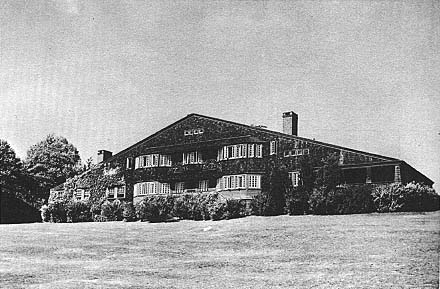
Peabody and Stearns - Kragsyde, Manchester-by-the-Sea,
MA (1882)
quintessential shingle style, entirely covered, asymmetric, chaotic,
huge, eccentric(cover - scully),
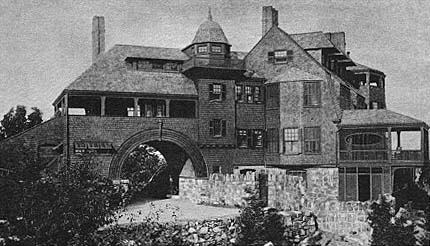
Peabody and Stearns - Rough Point, Newport, RI (1891)
inglenooks - gathering place around fireplace, romantic, rough american
landscape vs. living well with it,
by water with boulders, asymmetric, less "plasticity", eccentric,
assymetric, served v. servant, lots of entertaintment rooms,
and lots of servants quarters
Bruce Price - Tuxedo Park, NY (1880s)
rustic stone base, shingle siding - natural materials, roof envelops
one house, plasticity, english pictoral / picturesque,
neo romanesque, shingles wrap around front door for one of them, no
angles, fluid, (scully #107-110) (below - Kent House)
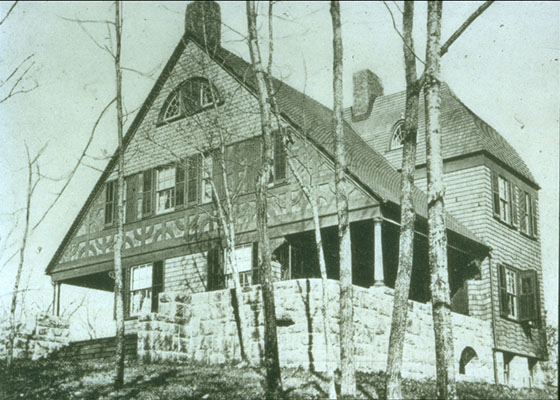
Henry Hobson Richardson - William Watts Sherman House, Newport, RI
(1874)
(scully 9-13), queen anne style living hall, picturesque, english-like,
gables (large frontal) and chimneys, big stair case with wood, dramatic
stairwell, windows - yellow and blue, stone base and shingle siding - like
tuxedo park houses (price), windows grouped in horizontal bands so even
though tall, still horizontal focus, masonry first floor(roth 166)
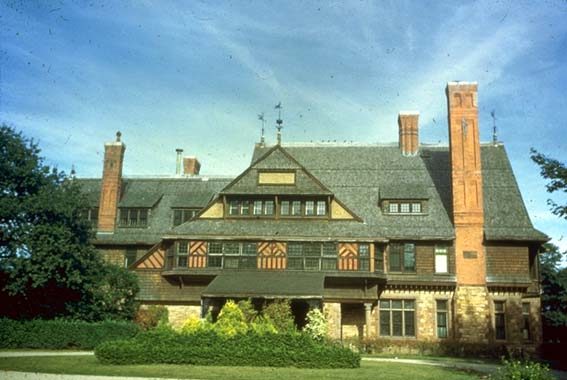
Henry Hobson Richardson - Stoughton House, Cambridge, MA (1882)
shingles go to ground, dormer window, horizontal emphasis, continuous,
simple, less picturesque more modern, shingle style (scully #57, roth 157)
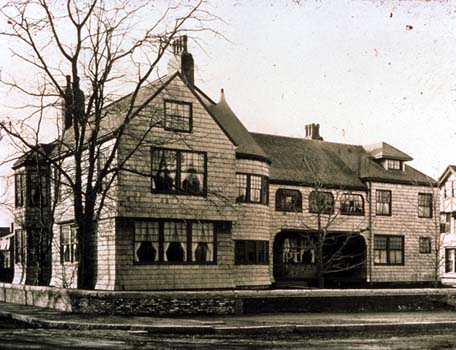
Henry Hobson Richardson - Trinity Church, Boston (1872-77)
very heavy masonry, european neo romanesque influence, masonry in sculptural
expression, tower, elements of victorian gothic and french romanesque,
(roth 165, o'gorman 27)

Henry Hobson Richardson - Allegheny County Courthouse, Pittsburgh,
PA (1884-87)
towers, very heavy masonry, continuous, seemless, taught, made impression
in town with huge tower, grey granite, tower is like hotel de ville of
cathedral tower,
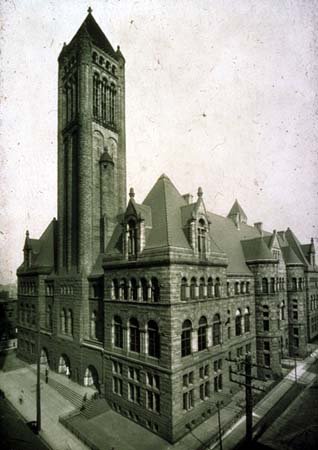
Henry Hobson Richardson - Crane Memorial Library, Quincy, MA (1880-82)
eyebrow dormers, like sullivan because you can tell function through
form, tell where reading rooms and stacks are, granite with red sandstone,
big entrance arch, asymmetry on axis, (o'gorman 41), lots of wood inside,

Henry Hobson Richardson - Marshall Field Wholesale Store,
reflects fact that there's comerce in trade, like Paladdio (florence),
took up entire block, first floors for merchants and baking, clean and
smooth, granite, classical composition - base-shaft-top like column, second
and third story in one big arch,
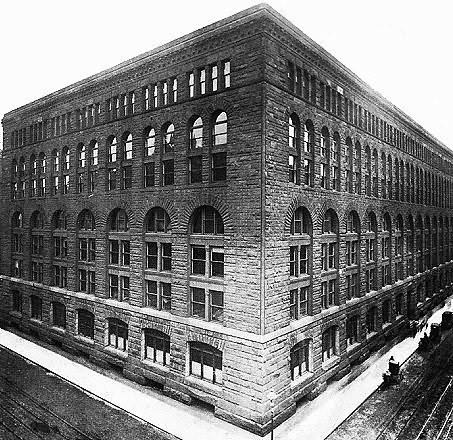
Henry Hobson Richardson - Glessner House, Chicago, IL (1885-87)
heavy stone on outside, granite - wealth, protection, U-shaped courtyard
plan, voids, light/dark, ashlar building rough on front but smooth on sides
and back, organic decoration, richardsonian arch over door, private organization,
grid window on bottom, backside - institutional (o'gorman 57)
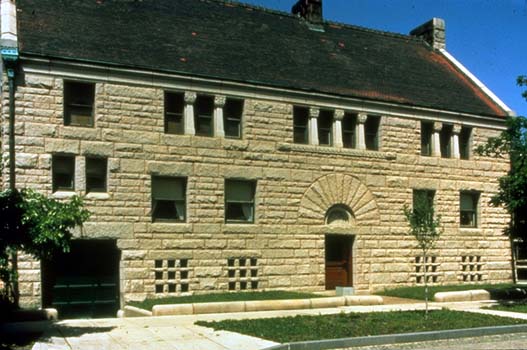
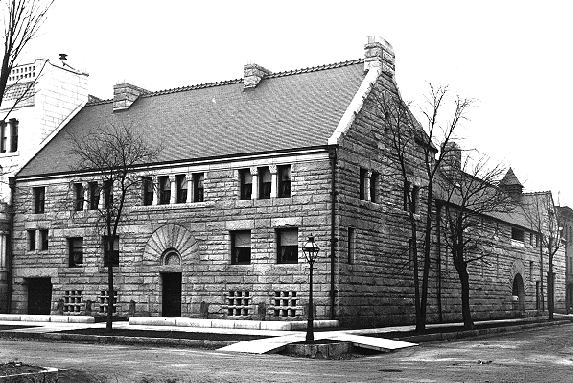
Henry Hobson Richardson - F.L. Ames Gate Lodge,
North Easton, MA (1880-81)
see rustic landscape though big arch, eyebrow dormers, heavy masonry
but not typical, (o'gorman 62)
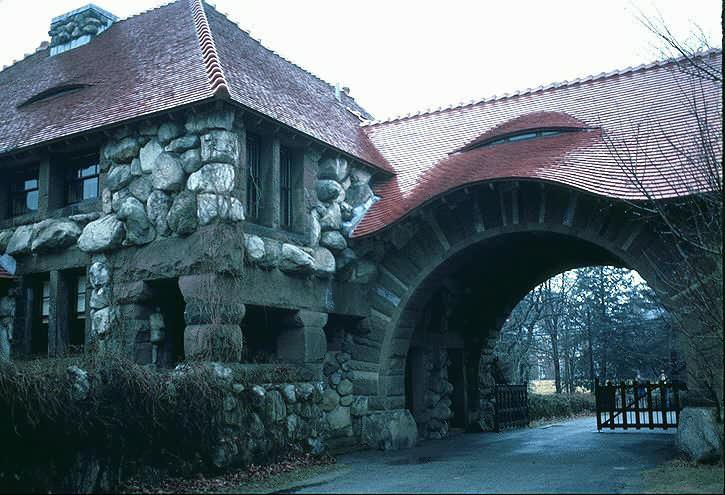
William LeBaron Jenney, Home Insurance Building, Chicago, IL (1883-85)
shows, potential for height, steel frame, only 10 stories though, new
commercial building type, base-shaft-top (roth 175)
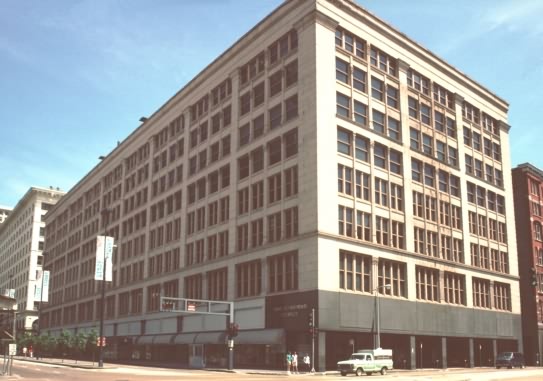
Burnham and Root - The Rookery, Chicago, IL (1885-87)
huge arch, birds roost, speculative office bldg, reddish color, hollow
square block with internal light court, decorated spandrels, bay windows
developed, smooth corners - modern, lobby like a train station, windows
follow stairs,
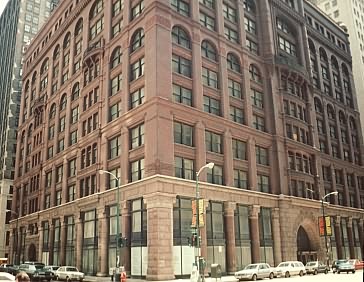
Burnham and Root - Monadnock, Chicago, IL (1889-92)
named after mountain, tallest masonry sturcture, steel on inside, base
tapers up (masonry), papyrus stock architecture, no projecting surfaces,
kept perfectly simple for solidity, modernism, 16 stories, (roth 176)
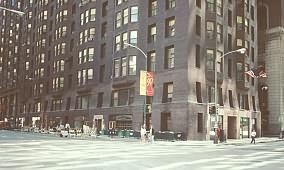
Burnham and Root - Reliance Building, Chicago, IL (1889-91, 94-95)
undulated pattern, almost all glazing, windows, because of steel, chicago
bay windows, extra masonry replaced by windows, ornamental spandrels of
terracotta, easy to clean, (roth 177)
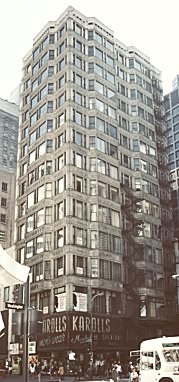
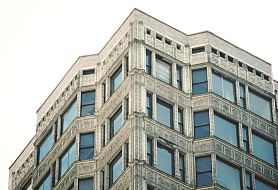
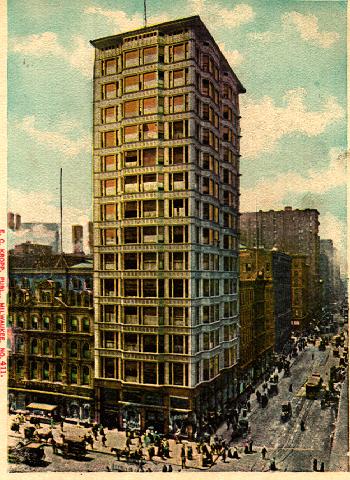
Adler and Sullivan - Auditorium Building, Chicago, IL (1886-90)
like marshall wharehouse, has big richardsonian arches, same tripartie
division, organic decorative, bottom stores have ashlar (like glessner)
retarded tower, newly available electricity (o'gorman 84)
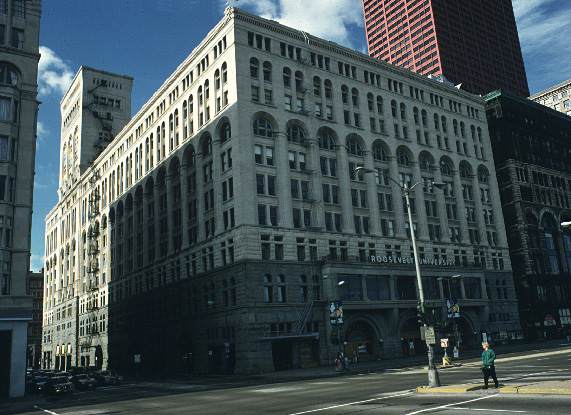
Adler and Sullivan - Wainwright Building, St. Louis, MO, (1890-91)
vertical lines of emphasis, structure and form of modern skyscraper,
tripartite construction, recessed ornamented spandrels, blocky, simple,
abstract, (jordy 301)
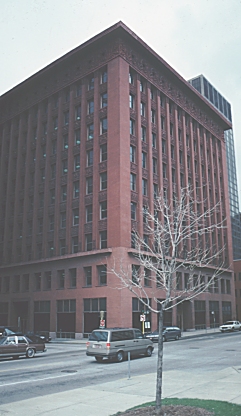
Adler and Sullivan - Guaranty Building, Buffalo, NY (1894-96)
(o'gorman 97)
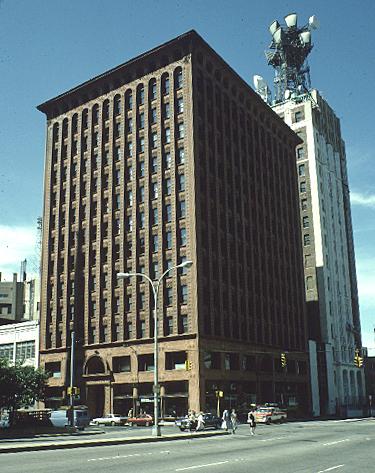
Adler and Sullivan - Carson, Pirie, Scott & Co. Store, Chicago,
IL (1891-1903)
horizontal emphasis for showcasing goods (roth 183)
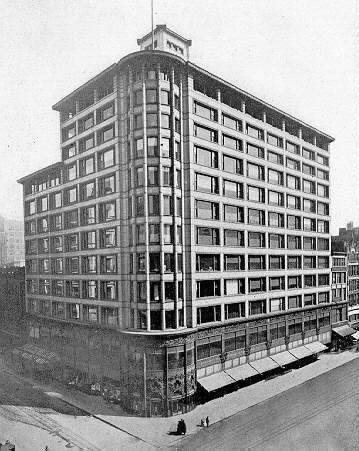
Columbian Exposition (1893) pictures...
Frank Lloyd Wright - His House and Studio, Oak Park, IL (1889-98)
suburban, based on Bruce Price's Chandler House in Tuxedo Park (big
triangular gable), shingle style, simplicity and repose just like richardson,
inglenook in core (from American Colonial), Palladian windows, wood extensively
used, breaks up surface, vertical stripe theme in freize, barrel vaulted
additions (like Richardson libraries), lots of built in furniture, (roth
201)
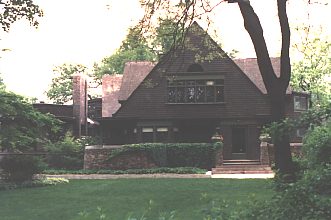
Frank Lloyd Wright - Blossom House, Chicago, IL (1892)
colonial, ionic capitals, projecting eaves, curves in back like Isaac
Bell House,
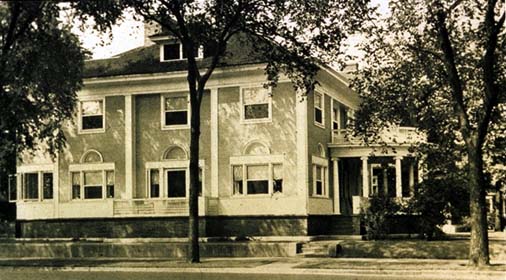
Frank Lloyd Wright - Thomas Gale House, Oak Park, IL (1892-1909)
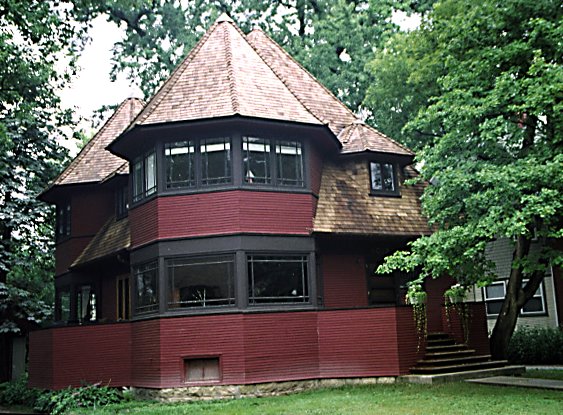
Frank Lloyd Wright - Walter Gale House, Oak Park, IL (1893)
shingle, neo-romanesque, curving form, tutor-chalet style, subltely
introduces things, huge dormer, planar, abstract,
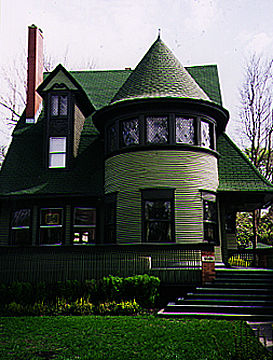
Frank Lloyd Wright - Winslow House, River Forest, IL (1893)
first real house, not derivative, central chimney, broad overhang covers
2nd floor windows, 2nd floor terracotta frieze, big limestone entrance,
inglenook, back to back fireplaces, rectangular dining room with semicircular
extension, porte cochere, water table, then roman buff brick, contrast
to chaotic back, based on Sullivan's works, entrance from Charlotte Wainwright
tomb in Stl. Louis, Richardsonian arch, like Glessner house with symettry
and strong front facade, simple square windows, tightly contained plan
(o'gorman 121, roth 202)
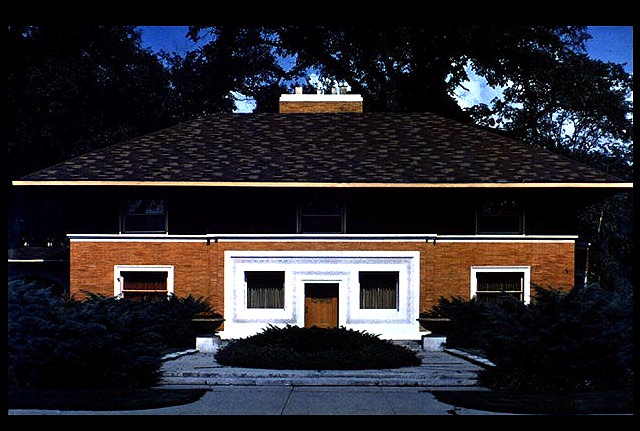
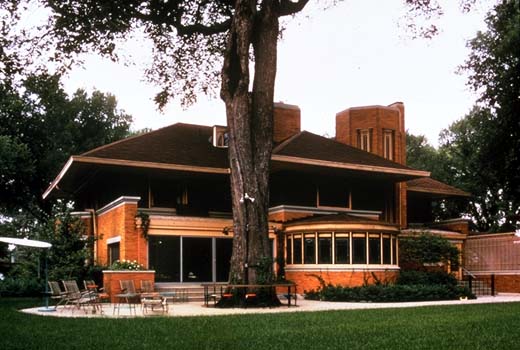
Frank Lloyd Wright - Moore House, Oak Park, IL (1895)
tudor, shingle, japanese-influenced roof, large arch, horizontal thrust,
again like Richardson's small libraries
Frank Lloyd Wright - Williams House, River Forest, IL (1895)
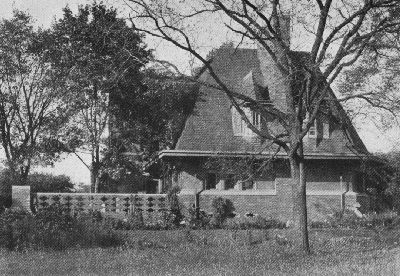
Frank Lloyd Wright - Goodrich House, Oak Park, IL (1896)
tudor, shingle, Japanese roof,
Frank Lloyd Wright - Dana House, Springfield, IL (1899)
large arch, horizontal thrust, like Richardson libraries,
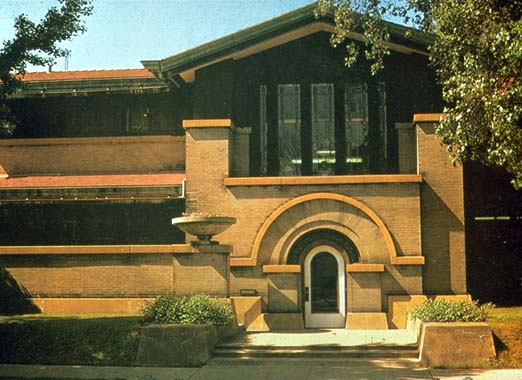

Frank Lloyd Wright - Heller House, Chicago, IL (1897)
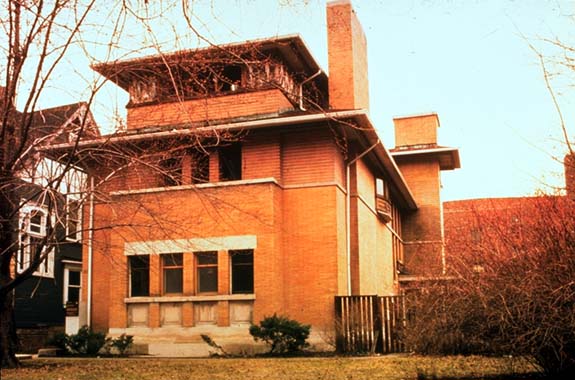
Frank Lloyd Wright - Ward Willits House, Highland Park, IL (1900-02)
radiates around fireplace, horizontal thrusts, spread out plan, each
room gets light from three sides, porte cochere, (o'gorman 135)
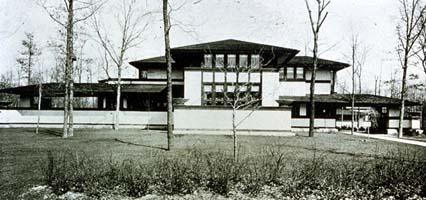
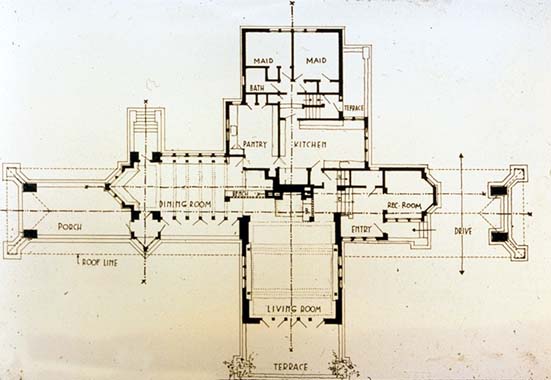
Frank Lloyd Wright - Thomas House, Oak Park, IL 1901
like Crane memorial library, big wall in front of veranda, big arch
means that this was early in career, very richardson influenced,
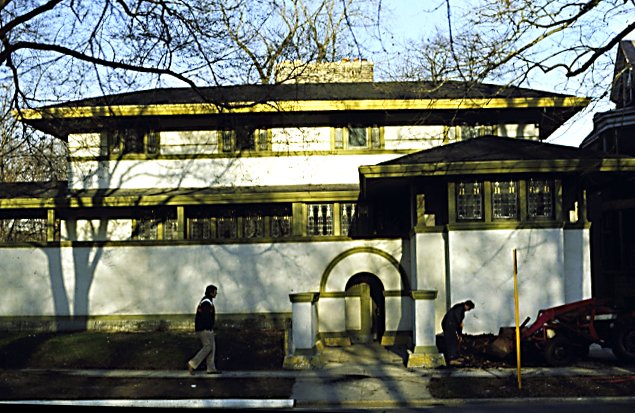
Frank Lloyd Wright - Fricke House, Oak Park, IL (1901-02)
verticality, blocky tower arrangement, smooth stucko not brick, framed
windows, no more curvy forms, very sharp angular "machine-like" forms,
again broad eaves and Japanese
Frank Lloyd Wright - Heurtley House, Oak Park, IL (1902)
very Richardsonian, like Crane Memorial Library, syrian arch,
tripartite external composition, repeated horizontal emphasis, brick sophisticatedly
used - arch, steel construction not expressed, huge chimney, (o'gorman
131)
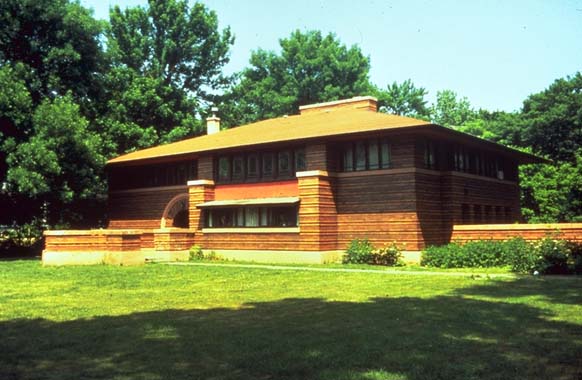
Frank Lloyd Wright - Cheney House, Oak Park, IL (1904)
prairie style,
Frank Lloyd Wright - Darwin Martin House, Buffalo, NY (1904)
living room with big richardsonian arch over fireplace, built in furniture/lighting
units, deep overhangs, roman brick
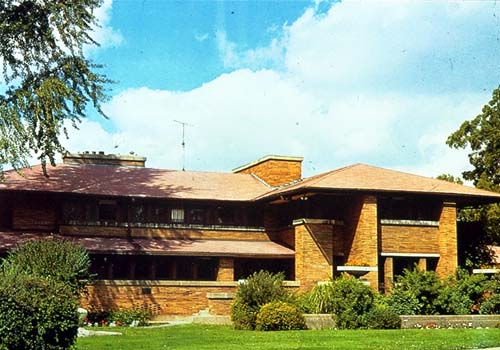
Frank Lloyd Wright - Hills House, Oak Park, IL (1906)
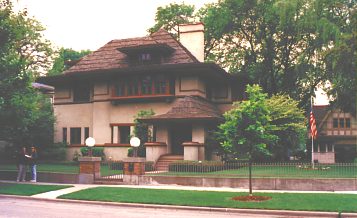
Frank Lloyd Wright - Roberts House, River Forest, IL (1908)
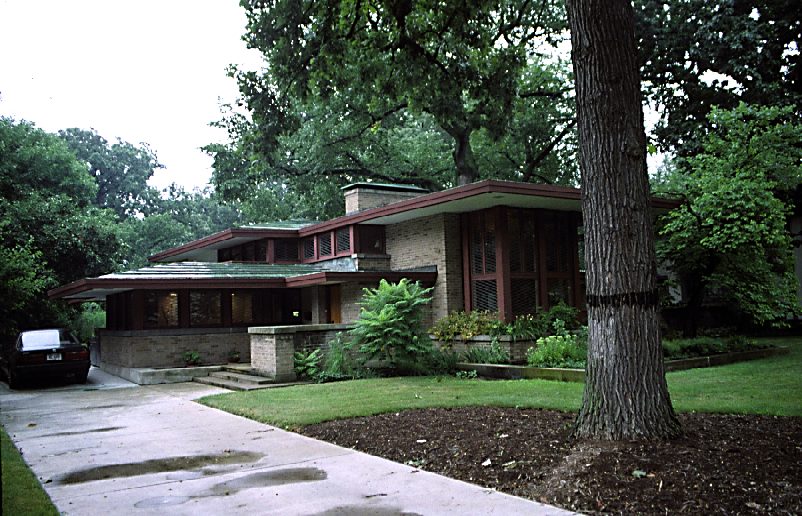
Frank Lloyd Wright - Ingalls House, River Forest, IL (1909)
Frank Lloyd Wright - Unity Church, Oak Park, IL (1904-7)
(jordy 302-4)
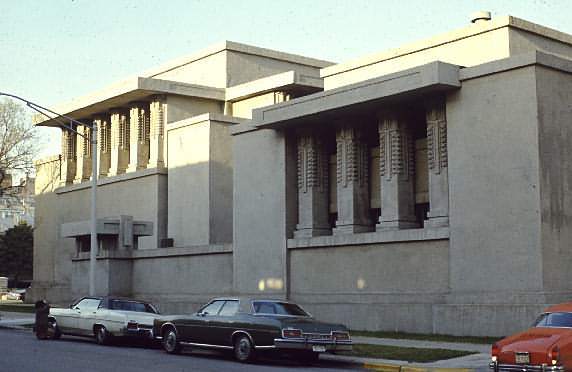
Frank Lloyd Wright - Robie
House, Chicago, IL (1909)
most famous prarie house, open plan (ie. no doors and walls but chimneys
instead), caps brick walls with white stone, simple plan, entrance in back
and same approach sequence as Isaac Bell House, uses Roman bricks to emphasize
horizontality - raked horiz. mortar to get shadow, and tinted vertical
mortar the same shade,

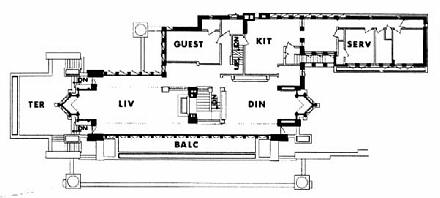
Frank Lloyd Wright - Imperial Hotel, Tokyo, Japan (1916-22)
Japanese roofing, detail, surfaces not blank but highly textured (geometric),
urns with plants brings nature in, reflecting pool,
.gif)
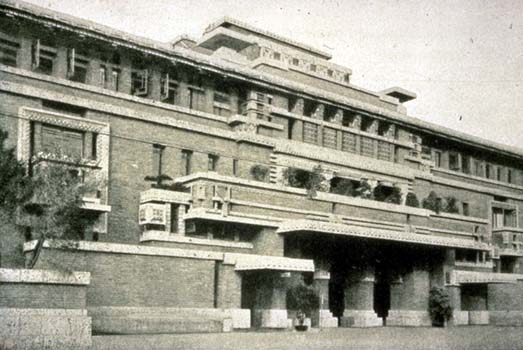
Frank Lloyd Wright - Barnsdall Hollyhock House, Hollywood, Los Angeles,
CA (1920)
beaux arts plan in symettric layout, but mayan or art deco exterior,
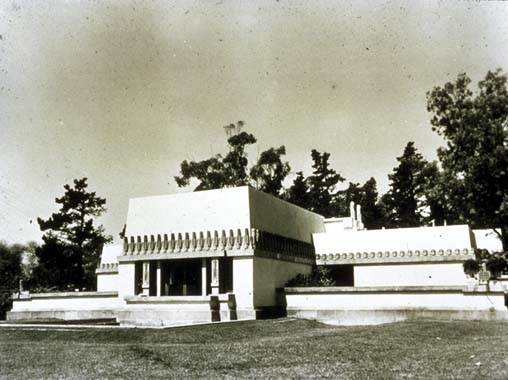
Frank Lloyd Wright - Ennis House, Hollywood, Los Angeles, CA (1924)
all patterenedd surface
Frank Lloyd Wright - Pope Leighey House, Mount Vernon, VA (1939)
small compact, in forest, very low, built in shelving and furniture,
pattern windows punched out of wood, also clerestory and plate glass windows
for lighting, affordable housing for everyone, L-shaped plan, "Reverse
board-and-batten 'sandwich' walls were incorporated to ease construction
and increase floor space" (http://www.oldtowncrier.com/Archives/otc998/features/feature4.htm),
heating through water pipes in cement slab floor, open floor plan, cantilevered
roof, carport, prefabricated walls, originally in Falls Church
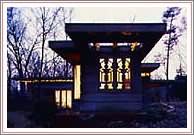

Frank Lloyd Wright - Usonian Loveness House (1954)
ambiguous indoor/outdoor, central chimney
Frank Lloyd Wright - Taliesin East, Spring Green, WI (1925-59)
back in WI, school and farm, roof lines echo low gentle hills of surrounding
site, roof going around tree,
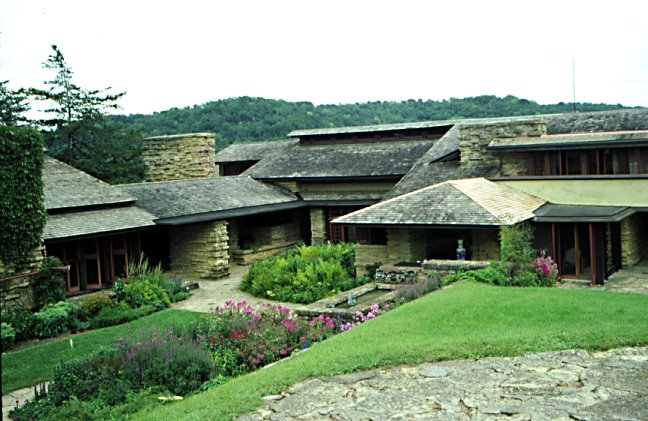
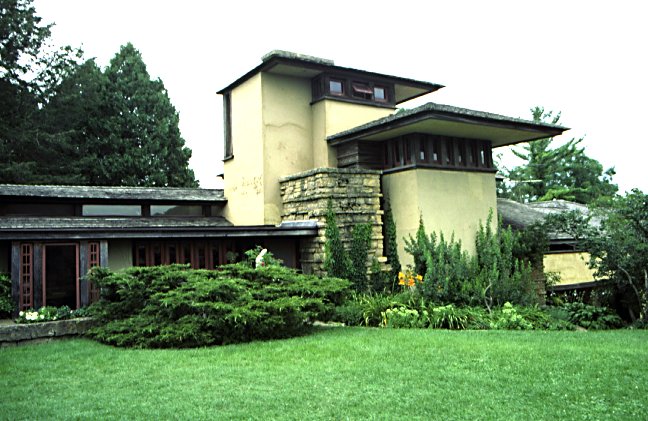
Frank Lloyd Wright - Fallingwater, Bear Run, PA (1936)
comes out of rock, (jordy 289)
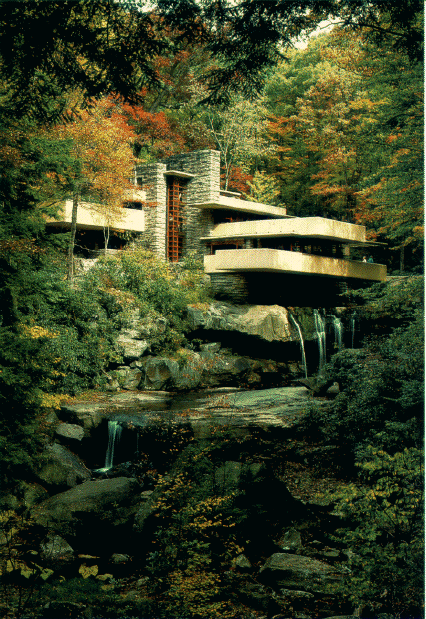
Frank Lloyd Wright - Johnson Wax Administration Building, Racine,
WI (1936-39)
temple of work, glass tubing for skylights, no windows, lilypads on
narrow columns supporting roof, like underwater, roof leaks, (jordy 309-10)
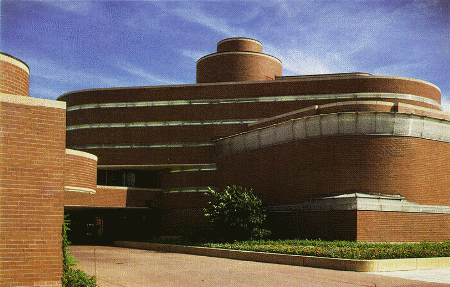
Frank Lloyd Wright - Solomon
R. Guggerheim Museum, New York, NY (1943-45, 56-59)
spiral plan, (roth 293), (jordy 292-293, 315, 322)
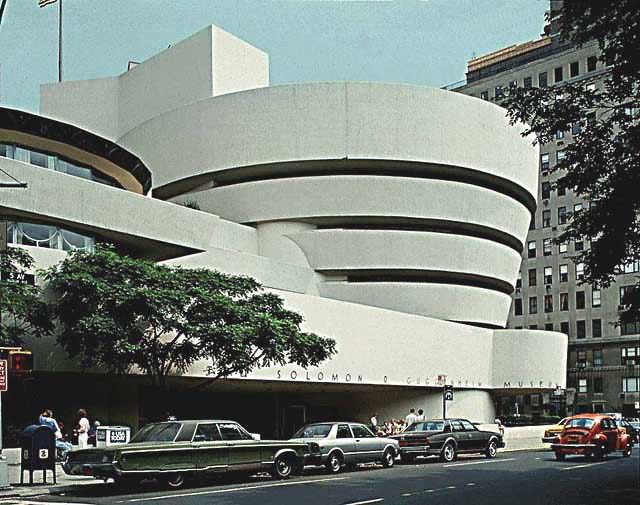
Ernest Flagg - Singer Building and Little Singer Building, New York,
NY (1902)
tower, docorative at top, cap, little singer building is in chicago
style - simpler
Cass Gilbert - Woolworth Building, New York, NY (1913)
gothis, steel cage construction, tower is like spires of gothic cathedral,
called "cathedral of commerce", gargoyles reference architects,
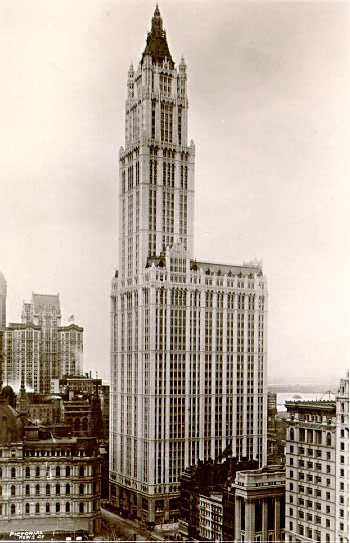
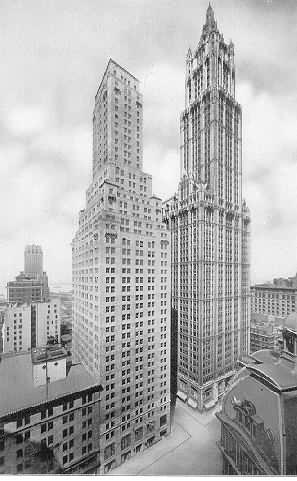
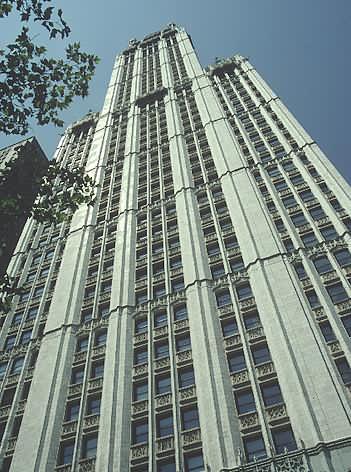
Hood and Howells - Chicago Tribune Tower, Chicago, IL - (1922)
gothic clad and top
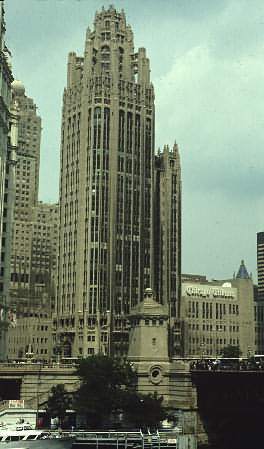
Graham, Anderson & Probst - Wrigley Building, Chicago, IL (1922)
connected by ..., quasi-Beaux Arts, tower, arcades, late chicago
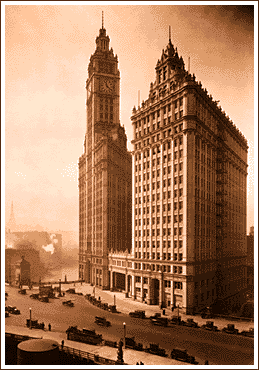
William van Alen - Chrysler Building, New York, NY (1928-30)
prototypical deco, machine-like corners, arched forms (hulls) at top,
triangular windows, celestial, gargoyles repeat hood ornament, like ziggurat's
sharp forms, mayan esthetic in lower part, wheels of automobile
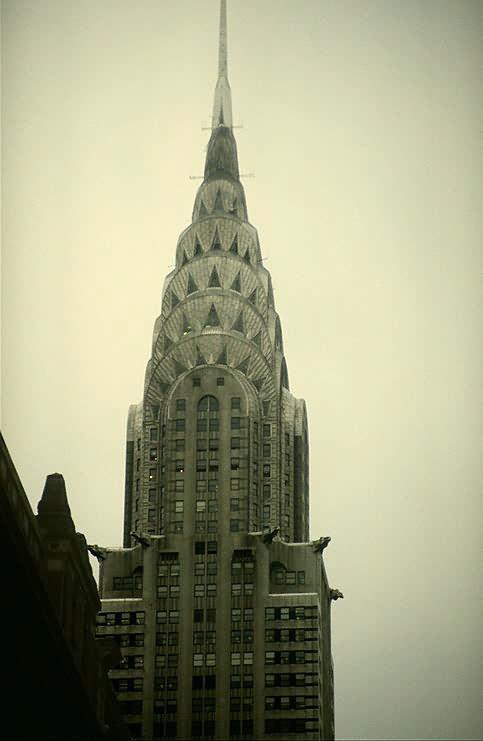
Shreve, Lamb and Harmon - Empire State Building, New York, NY (1931)
built during depression, speculative office building - not like the
chrysler with tenants already planned out, top has docking station for
blimps, last art deco skyscraper,
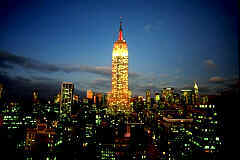
.gif)
Hofmeister, Hood, et al - Rockefeller Center, New York, NY (1931-39)
symmetric complex plan like city beautiful, Beaux Arts plan, verticality
emphasized in spandrels, skating rink at base, opera hall, decorated mythologically
but in deco
Howe and Lescaze - (PSFS) Philadelphia Savings Fund Society Building,
Philadelphia, PA (1931-32)
serious modernism, clean, simple, straight lines and curves, sets pattern
for next couple of decades, bank on second floor, shops below, functional
design, PSFS sign screens a/c, obviously modernist because of curved glass,
lots of light, volume, polished granite, no reliance on a single form,
20th floor (mechanical) expressed - no windows, continuous bands of glasing,
ribbon windows, horizontal and vertical expression, cantilevered bay,
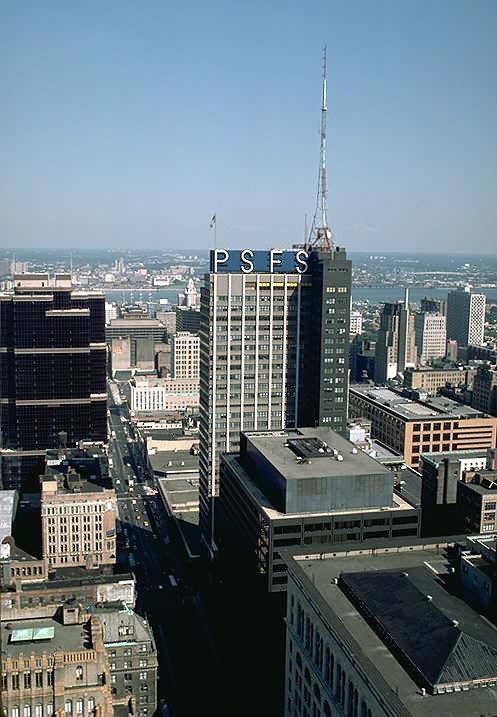
Walter Gropius - Bauhaus, Dessau, Germany (1925-26)
factory-like, machine age emerging, total design, cantilevered balconies
with "ship's" rails,
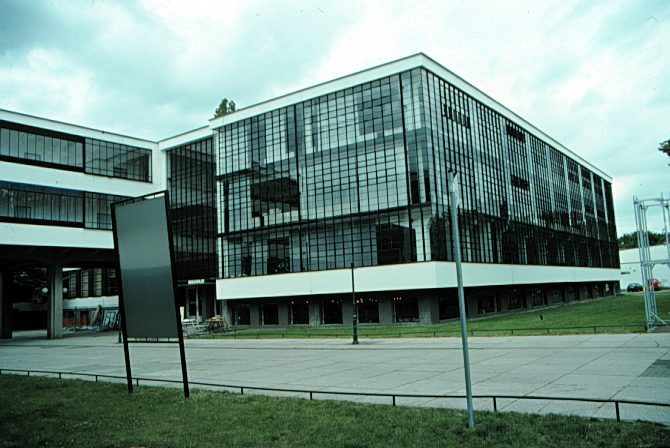
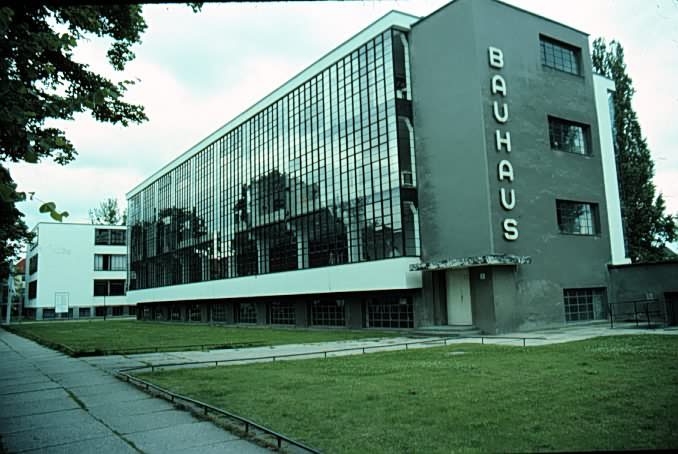
Walter Gropius - Gropius House, Lincoln, MA (1938)
thin walls, ribbon windows, wall of books, piloti, roof garden, glass
block walls
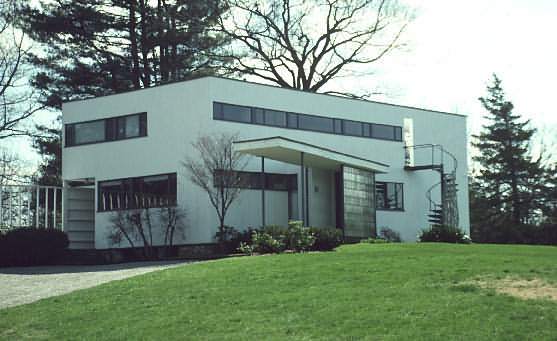
Mies van der Rohe - Barcelona Pavillion (1929)
"almost nothing", polished marble planes, simple but difficult because
everything is expressed
Mies van der Rohe - Farnsworth House, Plano, IL (1945-50)
simple plan, thin kitchen, glass exterior, off the ground, (roth 318)
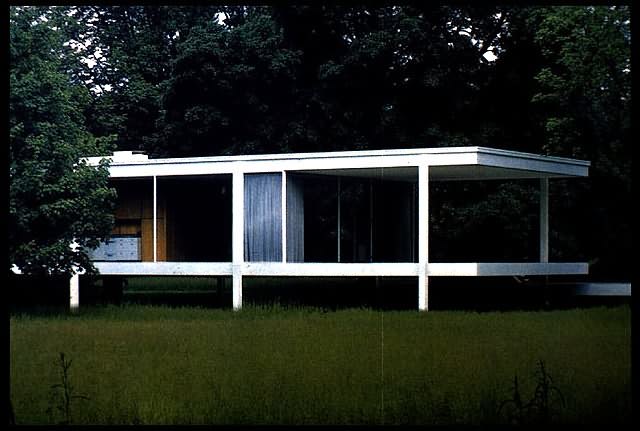
Mies van der Rohe - Lake Shore Drive Apartments 860-880, Chicago,
IL (1952)
(roth 283)
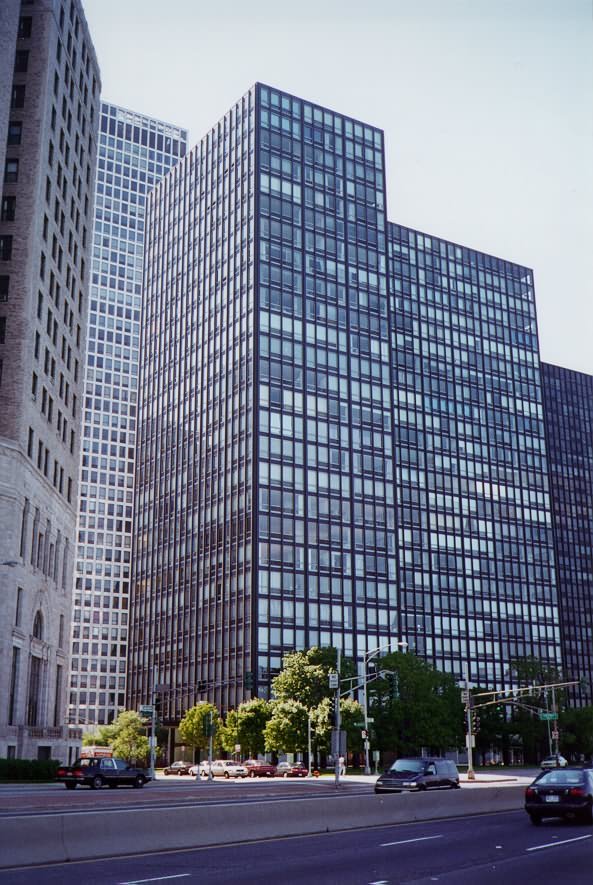
Mies van der Rohe - Crown Hall, Illinois Institute of Technology,
Chicago, IL (1956)
fins on roof - trusses that hold the building up (roth 282)
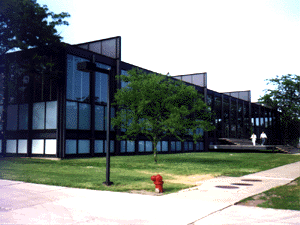
Mies van der Rohe with Philip Johnson - Seagram Building, New York,
NY (1957)
expensive, broze color because its the color of scotch, bronze tinted
glasing, plaza paved in travertine in front so that the whole building
can be taken in by bypassers, granite pillars at base, 2 story lobby, projecting
i-beams accentuate verticality, (jordy 275)
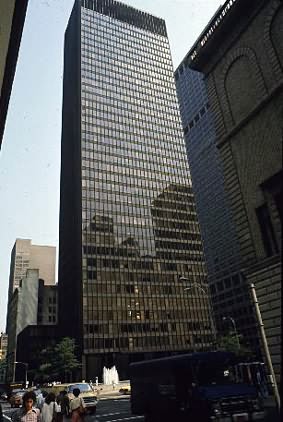
Gordon Burnshaft for Skidmore, Owings, and Merrill - Lever Building,
New York, NY (1952)
follows the street with base, tower rotated 90 degrees to the street
so it stands out, 21 stories, green glass with blue/grey spandrels, mezzanine
on pilotis, (Roth 278),
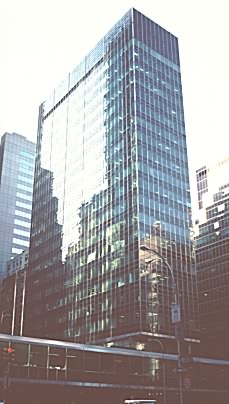
Gordon Burnshaft for Skidmore, Owings, and Merrill - Inland Steel,
Chicago, IL, (1952)
green glass box held withing aluminum spandrels, columns, cantilevered
portion

Gordon Burnshaft for Skidmore, Owings, and Merrill - Beinecke Rare
Books Library, Yale University, New Haven, CT (1961)
concrete fram construction, alabaster panels make warm glow on inside
and protect rare books from harmful direct light, (roth 305)
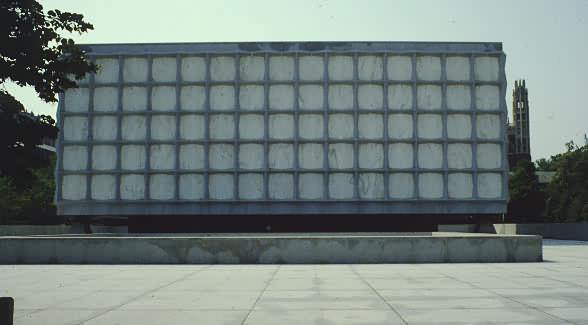

Harrison and Abramowitz - The United Nations Complex, New York, NY
(1947-53)
along east river, originally designed by La Coursier, parking below
building
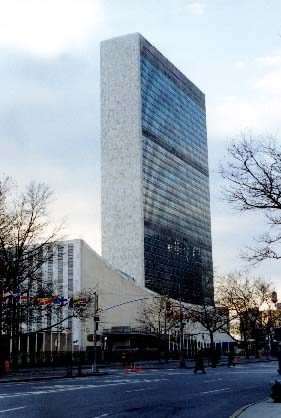
Rudolpf Schindler - The Lovell Beach House, Newport Beach, CA (1925-26)
very simple, 5 fins, glass box is big living hall, called "health"
house because of clean ocean breezes, bedrooms above, reinforced concrete
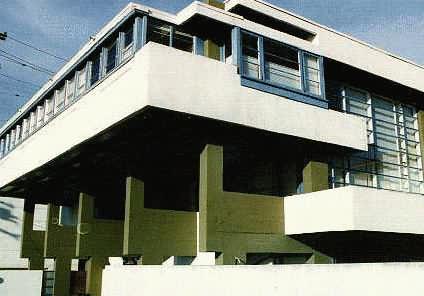
Richard Neutra - The Lovell House, Los Angeles, CA (1927)
steel fram construction, reminiscent of Fallingwater, hovering above
land (European modernism), white
Philip Johnson - The Glass House, New Canaan, CT (1945-49)
intended to be weekend retreat, too modern to be liveable, bathroom
in backside of fireplace, (roth 319-21)
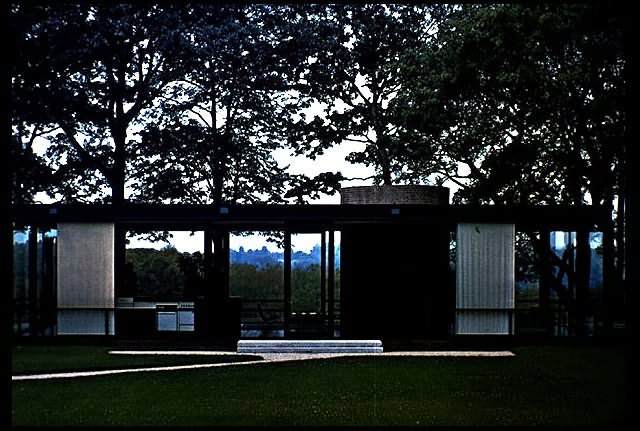
Philip Johnson - Addition to Boston Public Library (1964-67, 69-73)
arch theme expanded to big three arches,

Philip Johnson and John Burgee - The AT&T Building, New York,
NY (1978)
looks like a piece of furniture,
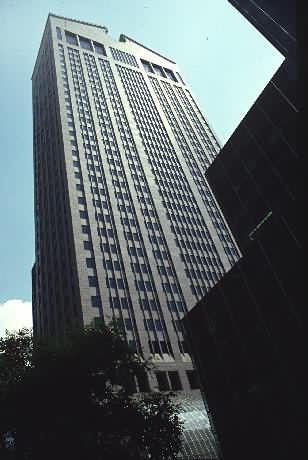
Eero Saarinen - Jefferson Memorial Arch, St. Louis, MO (1948)
Eero Saarinen - General Motors Technical Center, Warren, MI (1948-56)
Eero Saarinen - Ingalls Hockey Rink, Yale University, New Haven,
CT (1956-58)
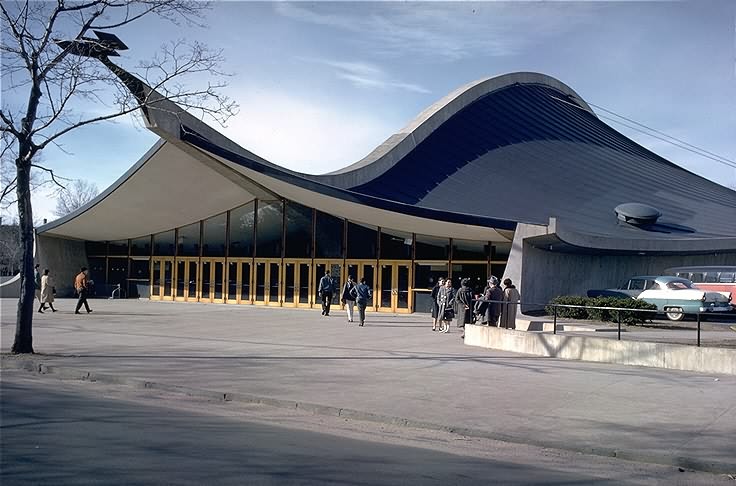
Eero Saarinen - TWA Terminal, Kennedy Airport, New York, NY (1956-62)
(roth 296)
.gif)
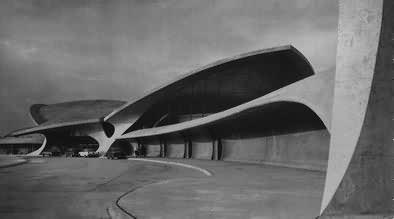
Eero Saarinen - Dulles International Airport, Chantilly, VA (1961-63)
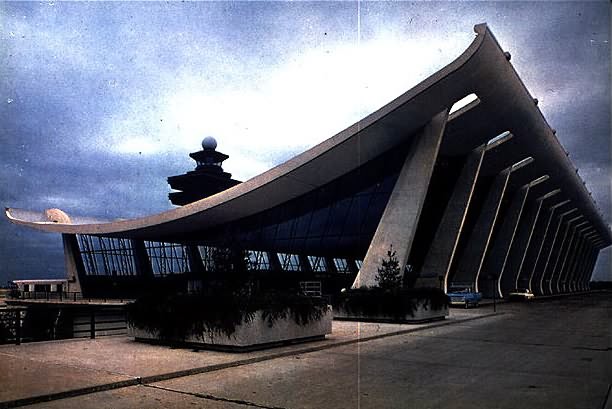
Paul Rudolph - Art and Architecture Building, Yale University, New
Haven, CT (1958-64)
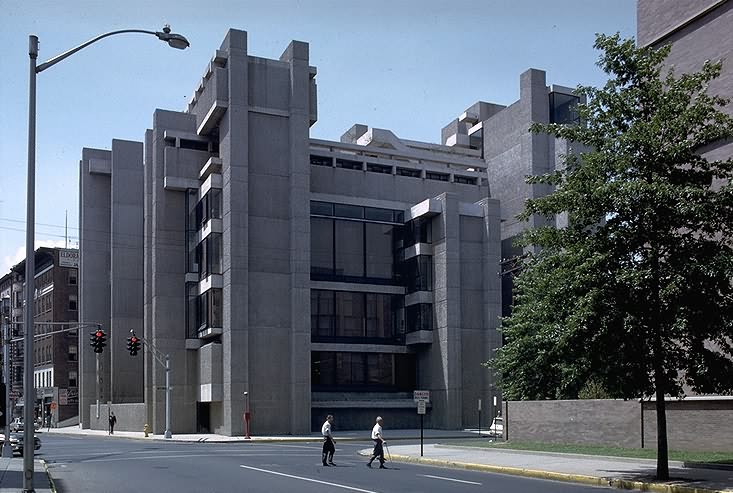
Louis Kahn - Richards Medical Research Laboratories, U. of Penn.,
Philadelphia, PA (1957-61)
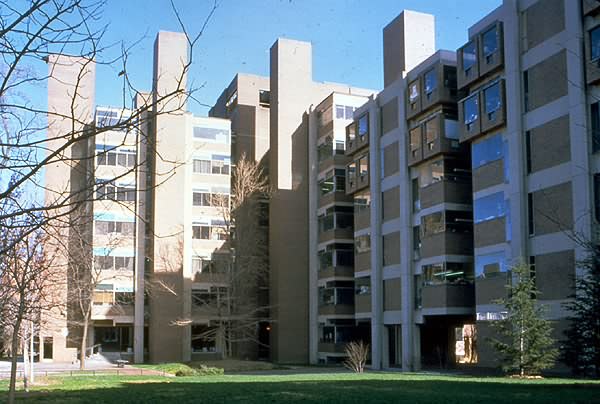
Louis Kahn - Jonas Salk Institute for Biological Studies, La Jolla,
CA (1959-65)
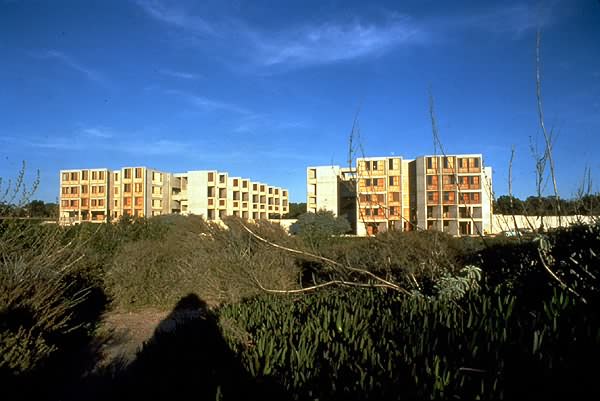
Louis Kahn - Residence Hall, Bryn Mawr College, Bryn Mawr, PA (1960-65)
Louis Kahn - Kimball Art Museum, Fort Worth, TX (1974-78)
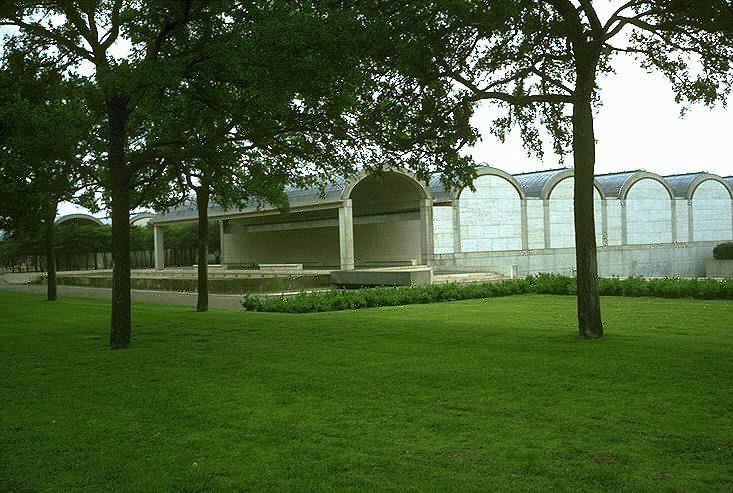
Louis Kahn - British Art Center, Yale University, New Haven, CT (1969-72,
72-77)
Bruce Graham for Skidmore, Owings, and Merrill - John Hancock Center,
Chicago, IL (1965-70)
(roth 289)
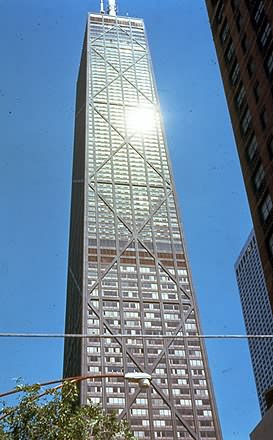
Skidmore, Owings, and Merrill - Sears Tower, Chicago, IL (1970-74)
(roth 290)
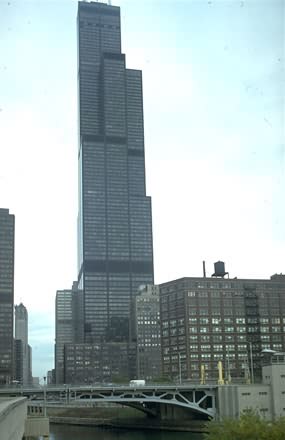
Sources -
http://www.brynmawr.edu/Acads/Cities/98-city255/survs.html
http://www.archinform.de/restart.en.htm
http://www.bc.edu/bc_org/avp/cas/fnart/fa267/contents.html
http://www.adelaide.net.au/~jpolias/FLW/
http://www.bluffton.edu/~sullivanm/
http://www.oldtowncrier.com/Archives/otc998/features/feature4.htm
http://www.thais.it/guggenheim/default_uk.htm
A Concise History of American Architecture, by Leland Roth, Westview Press, 1980
The Shingle Style & the Stick Style, by Vincent Scully, Yale U. Press, 1971
Three American Architects: Richardson, Sullivan, and Wright, by James O'Gorman, U. of Chicago Press, 1992
American Buildings and their Architects, Volume 5, by William Jordy, Oxford U. Press, 1986